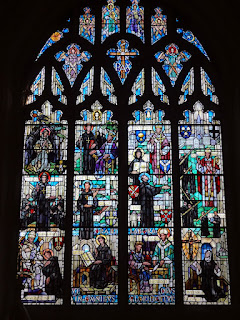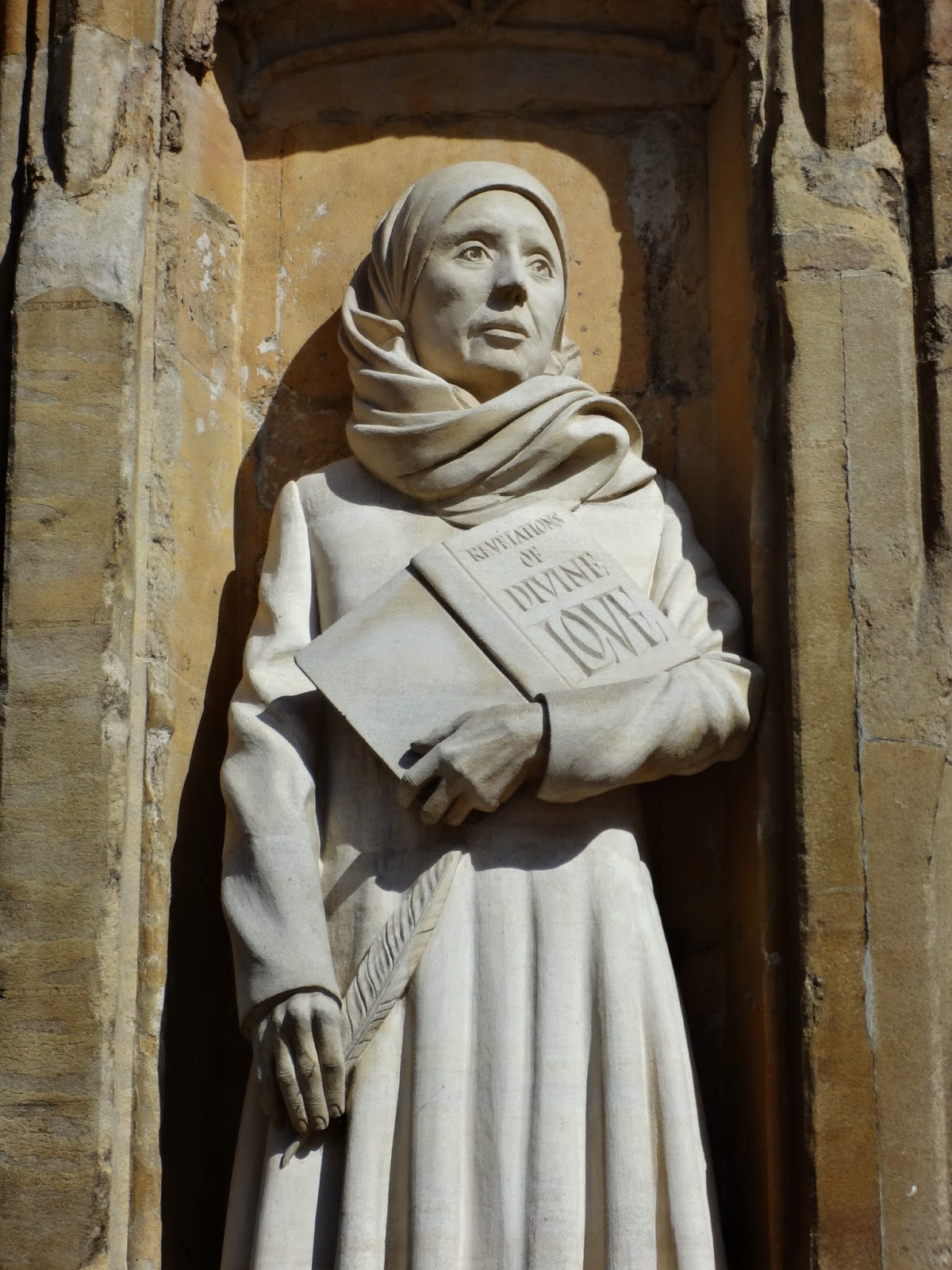There, as you would expect, they are very keen on Julian of Norwich. As she is my Lenten reading at the moment, I was totally on board with this. Here she is in a modern window from the rebuilt church of St Julian, on the site of the medieval church where she was an anchoress and from which she took her name, but which was sadly bombed in World War Two:
 This window looks from the small side-chapel on the site of her anchorite's cell, through to the chancel. Anchorites used to have small windows looking in from their cells to the church so they could see Mass being said at the altar, and I suppose this window is roughly where Julian's would have been (though much bigger, I should think!). The text says, like everything else at this church which has become a shrine to her, 'All shall be well'.
This window looks from the small side-chapel on the site of her anchorite's cell, through to the chancel. Anchorites used to have small windows looking in from their cells to the church so they could see Mass being said at the altar, and I suppose this window is roughly where Julian's would have been (though much bigger, I should think!). The text says, like everything else at this church which has become a shrine to her, 'All shall be well'.She is also commemorated in a (very) modern life-size statue on the front of Norwich Cathedral, commissioned to celebrate the millennium. She and St Benedict together flank the west door, which probably would have horrified humble Julian.
 Here she is again, next to St Edmund, and complete with cat:
Here she is again, next to St Edmund, and complete with cat:On the premise that some anchoresses had cats (it's in Ancrene Wisse, if I remember rightly).
Next to Edmund and Julian are two saints who brought Christianity to East Anglia, St Felix of Burgundy and St Fursey:
 Fursey was an Irish monk who famously had visions of the afterlife; Felix the first bishop in East Anglia. After the monastery he founded was destroyed by the Vikings, Felix's relics were transferred (during the reign of Cnut, patron of the Fenland abbeys) to Ramsey Abbey.
Fursey was an Irish monk who famously had visions of the afterlife; Felix the first bishop in East Anglia. After the monastery he founded was destroyed by the Vikings, Felix's relics were transferred (during the reign of Cnut, patron of the Fenland abbeys) to Ramsey Abbey.The rest of the pictures are from one window in Norwich Cathedral, a tribute to the cathedral's Benedictine history, installed in 1963. This is what the whole thing looks like:

In chronological order, we have St Benedict:

And Gregory sending Augustine to convert the English:

Here's Augustine arriving in Kent (last seen in glass here), and meeting King Æthelbert - under a tree, note, because Æthelbert insisted on meeting Augustine in the open air lest the Christians put spells on him:
 And then the founder of Bede's monastery at Wearmouth-Jarrow, Benedict 'Biscop', who also, appropriately, was the first to introduce glass-makers into England, from France. So without him this whole post wouldn't exist...
And then the founder of Bede's monastery at Wearmouth-Jarrow, Benedict 'Biscop', who also, appropriately, was the first to introduce glass-makers into England, from France. So without him this whole post wouldn't exist...I like the glass window he's holding in his hand. And next Bede himself (looking rather younger than usual!):

Skipping on a few centuries, we have Dunstan, Oswald and Æthelwold, leaders of the tenth-century Benedictine Revival which reinvigorated monasticism in England:

And passing swiftly over the Norman Conquest we have St Anselm, and as a bonus Henry I, who seems to get himself into these windows despite not being very saintly at all (there's a similar one at Canterbury in which he also appears):

I choose to imagine that the window depicts them having this conversation.
And we will end, as seems appropriate, with Julian again:
"And after thys oure Lorde brought to my mynde the longyng that I had to hym before. And I saw nothyng lettyd my but synne, and so I behelde generally in us alle. And me thought yf synne had nott be, we shulde alle have be clene and lyke to our Lorde as he made us. And thus in my foly before thys tyme often I wondryd why, by the grete forseyng wysdom of God, the begynnyng of synne was nott lettyd. For then thought me that alle shulde have be wele.
Thys steryng was moch to be forsaken. And, nevyrthelesse, mornyg and sorow I made therfore withoute reson and dyscrecion. But Jesu, that in this vysyon enformed me of alle that me nedyd, answeryd by thys worde and seyde, Synne is behovely, but alle shalle be wele, and alle shalle be wele, and alle maner of thynge shalle be wele."
The Showings of Julian of Norwich, ch.27.




1 comment:
Thank you.
Post a Comment